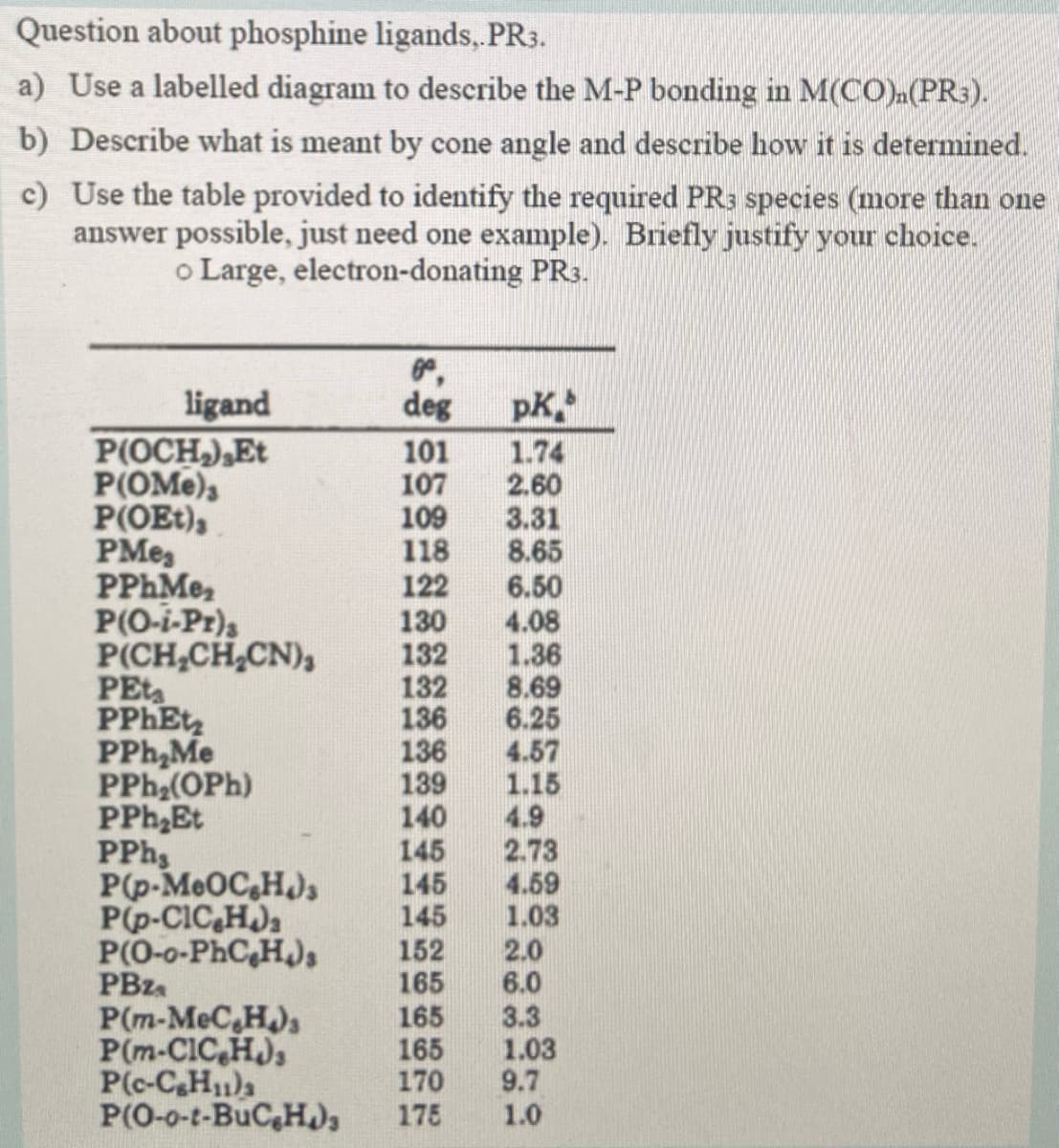Question about phosphine ligands,.PR3. a) Use a labelled diagram to describe the M-P bonding in M(CO)a(PR3). b) Describe what is meant by cone angle and describe how it is determined. c) Use the table provided to identify the required PR3 species (more than one answer possible, just need one example). Briefly justify your choice. o Large, electron-donating PR3. ligand P(OCH),Et P(OMe), P(OEt), PMeg PPhMe, P(O-i-Pr), P(CH,CH,CN), PEt PPhEt PPh,Me PPh (OPh) PPh,Et PPh P(p-MeOC,HJ, Pp-CIC,H)a P(0-0-PhC,H), PBZA deg pK 101 107 109 118 122 130 132 132 136 136 139 140 145 145 145 152 165 1.74 2.60 3.31 8.65 6.50 4.08 1.36 8.69 6.25 4.57 1.15 4.9 2.73 4.59 1.03 2.0 6.0
Question about phosphine ligands,.PR3. a) Use a labelled diagram to describe the M-P bonding in M(CO)a(PR3). b) Describe what is meant by cone angle and describe how it is determined. c) Use the table provided to identify the required PR3 species (more than one answer possible, just need one example). Briefly justify your choice. o Large, electron-donating PR3. ligand P(OCH),Et P(OMe), P(OEt), PMeg PPhMe, P(O-i-Pr), P(CH,CH,CN), PEt PPhEt PPh,Me PPh (OPh) PPh,Et PPh P(p-MeOC,HJ, Pp-CIC,H)a P(0-0-PhC,H), PBZA deg pK 101 107 109 118 122 130 132 132 136 136 139 140 145 145 145 152 165 1.74 2.60 3.31 8.65 6.50 4.08 1.36 8.69 6.25 4.57 1.15 4.9 2.73 4.59 1.03 2.0 6.0
Chemistry
10th Edition
ISBN:9781305957404
Author:Steven S. Zumdahl, Susan A. Zumdahl, Donald J. DeCoste
Publisher:Steven S. Zumdahl, Susan A. Zumdahl, Donald J. DeCoste
Chapter1: Chemical Foundations
Section: Chapter Questions
Problem 1RQ: Define and explain the differences between the following terms. a. law and theory b. theory and...
Related questions
Question
100%

Transcribed Image Text:Question about phosphine ligands, PR3.
a) Use a labelled diagram to describe the M-P bonding in M(CO)n(PR3).
b) Describe what is meant by cone angle and describe how it is determined.
c) Use the table provided to identify the required PR3 species (more than one
answer possible, just need one example). Briefly justify your choice.
o Large, electron-donating PR3.
ligand
P(OCH),Et
P(OMe),
P(OEt),
PMes
PPhMe,
P(O-i-Pr)s
P(CH,CH,CN),
PEt
PPhEt
PPh,Me
PPh (OPh)
PPh,Et
PPh,
P(p-MeOC,H),
Pp-CIC,H).
P(0-0-PhC,H),
PBZA
P(m-MeC,H.),
P(m-CIC,H.),
P(c-CH1)a
P(O-0-t-BuC Hda
deg
pK.
101
107
109
118
122
130
132
132
136
136
139
140
145
145
145
1.74
2.60
3.31
8.65
6.50
4.08
1.36
8.69
6.25
4.57
1.15
4.9
2.73
4.59
1.03
2.0
6.0
3.3
1.03
9.7
152
165
165
165
170
175
1.0
Expert Solution
This question has been solved!
Explore an expertly crafted, step-by-step solution for a thorough understanding of key concepts.
This is a popular solution!
Trending now
This is a popular solution!
Step by step
Solved in 2 steps

Knowledge Booster
Learn more about
Need a deep-dive on the concept behind this application? Look no further. Learn more about this topic, chemistry and related others by exploring similar questions and additional content below.Recommended textbooks for you

Chemistry
Chemistry
ISBN:
9781305957404
Author:
Steven S. Zumdahl, Susan A. Zumdahl, Donald J. DeCoste
Publisher:
Cengage Learning

Chemistry
Chemistry
ISBN:
9781259911156
Author:
Raymond Chang Dr., Jason Overby Professor
Publisher:
McGraw-Hill Education

Principles of Instrumental Analysis
Chemistry
ISBN:
9781305577213
Author:
Douglas A. Skoog, F. James Holler, Stanley R. Crouch
Publisher:
Cengage Learning

Chemistry
Chemistry
ISBN:
9781305957404
Author:
Steven S. Zumdahl, Susan A. Zumdahl, Donald J. DeCoste
Publisher:
Cengage Learning

Chemistry
Chemistry
ISBN:
9781259911156
Author:
Raymond Chang Dr., Jason Overby Professor
Publisher:
McGraw-Hill Education

Principles of Instrumental Analysis
Chemistry
ISBN:
9781305577213
Author:
Douglas A. Skoog, F. James Holler, Stanley R. Crouch
Publisher:
Cengage Learning

Organic Chemistry
Chemistry
ISBN:
9780078021558
Author:
Janice Gorzynski Smith Dr.
Publisher:
McGraw-Hill Education

Chemistry: Principles and Reactions
Chemistry
ISBN:
9781305079373
Author:
William L. Masterton, Cecile N. Hurley
Publisher:
Cengage Learning

Elementary Principles of Chemical Processes, Bind…
Chemistry
ISBN:
9781118431221
Author:
Richard M. Felder, Ronald W. Rousseau, Lisa G. Bullard
Publisher:
WILEY